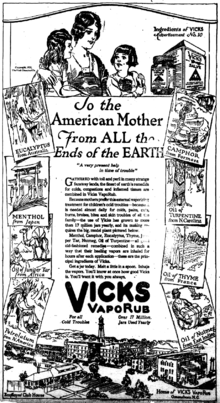Vicks VapoRub

Vicks VapoRub ointment is a mentholated topical ointment, part of the Vicks brand of over-the-counter medications owned by the American pharmaceutical company Procter & Gamble. VapoRub is indicated for use on the chest, back and throat for cough suppression or on muscles and joints for minor aches and pains. It has also been used to treat mosquito bites. Users of VapoRub often apply it immediately before sleep.
First sold in 1905, VapoRub was originally manufactured by the family-owned company Richardson-Vicks, Inc., based in Greensboro, North Carolina. Richardson-Vicks was sold to Procter & Gamble in 1985 and is now known as Vicks. VapoRub is also manufactured and packaged in India and Mexico. In German-speaking countries (apart from Switzerland), it is sold under the name Wick VapoRub.[1] VapoRub continues to be Vicks's flagship product internationally, and the Vicks brand name is often used synonymously with the VapoRub product.
History
According to Joe Schwarcz, the product can be traced to Jules Bengue, a French pharmacist, who created Ben-Gay, a menthol-based treatment for arthritis, gout and neuralgia. Lunsford Richardson, a pharmacist in Selma, North Carolina, sold Ben-Gay and heard from his customers that it cleared their sinuses. He blended menthol into petroleum jelly, at first calling it Richardson's Croup and Pneumonia Cure Salve, later changing the name to Vicks VapoRub. It was named after Richard's brother-in-law, Joshua Vick, a physician who had arranged for Richardson to have access to a laboratory to create the product. Richardson began selling it in 1905.[2]
Safe use

VapoRub can be inhaled with hot steam. Since VapoRub ointment is an oil-based medication, it should not be used under or inside the nose or inside the mouth, and it should not be swallowed. Any oil-based product can get into the lungs if used improperly.[3]
In pre-clinical animal studies, the application of Vicks VapoRub directly onto the tracheae of ferrets caused an increase in mucus production compared to a water-based lubricant.[4] However, since the authors used a water-based and not oil-based compound as a control, it is not possible to ascertain which component of Vicks VapoRub caused the increased mucus production. Because Vicks VapoRub was also directly applied to the ferret trachea, it is also difficult to extrapolate the results from this study to comment on possible irritation arising from the safe use of Vicks VapoRub in humans.
A Penn State study showed Vicks VapoRub to be more effective than placebo petroleum rub for helping cough and congestion with regards to helping children and adults sleep.[5] However, the study also showed that, unlike with the petroleum rub placebo, Vicks VapoRub was associated with burning sensations to the skin (28%), nose (14%) and eyes (16%), with 5% of study participants reporting redness and rash when using the product.[6]
Another study suggests VapoRub is an effective cough medicine for guinea pigs.[7] It has been suggested that VapoRub can reduce or cure onychomycosis (nail fungus).[8]
Ingredients
The ingredients, as listed on older product labels, are: camphor, menthol, spirits of turpentine, oil of eucalyptus, cedar leaf, nutmeg, and thymol, all "in a specially balanced Vick formula".
Active Ingredients:
Label reads: Active Ingredients (Purpose)
Regular:
| Ingredient | % | Purpose |
|---|---|---|
| Camphor (synthetic) | 4.8% | Cough suppressant and topical analgesic |
| Eucalyptus oil | 1.2% | Cough suppressant |
| Menthol | 2.6% | Cough suppressant and topical analgesic |
Lemon:
| Ingredient | % | Purpose |
|---|---|---|
| Camphor (synthetic) | 4.7% | Cough suppressant and topical analgesic |
| Eucalyptus oil | 1.2% | Cough suppressant |
| Menthol | 2.6% | Cough suppressant and topical analgesic |
Inactive Ingredients
Regular & Lemon:
- cedarleaf oil
- nutmeg oil
- petrolatum
- thymol
- turpentine oil
Lemon:
- lemon fragrance
Asia
In India, Vicks VapoRub is made by Procter & Gamble (P&G). The formulation is almost the same as the one stated above. P&G states Vicks Vaporub to be an Ayurvedic Medicine, which is indicated on the package. The ingredients (per 100 g of product) are stated as follows:
| Ingredient | English | Amount |
|---|---|---|
| Pudinah ke phool | Menthol | 2.82 g |
| Karpoor | Camphor | 5.25 g |
| Ajowan ke phool | Thymol | 0.10 g |
| Tarpin ka tel | Turpentine oil | 5.57 ml |
| Nilgiri tel | Eucalyptol | 1.49 ml |
| Jatiphal tel | Nutmeg oil | 0.54 ml |
| Ointment base q.s. |
See also
References
- ↑ "WICK Vaporub Erkältungssalbe: gegen Erkältung | Wick". Wick.de. 2016-01-02. Retrieved 2017-06-17.
- ↑ Schwarcz, Joe (2003). Dr. Joe and what You Didn't Know. Toronto: ECW Press. p. 142.
- ↑ "Vicks VapoRub Topical Ointment Children's Cough Medicine". vicks.com. Retrieved June 17, 2017.
Do not use: by mouth, with tight bandages, in nostrils, in wounds or damaged skin
- ↑ Abanses, Juan Carlos; Arima, Shinobu; Rubin, Bruce K. (January 2009). "Vicks VapoRub Induces Mucin Secretion, Decreases Ciliary Beat Frequency, and Increases Tracheal Mucus Transport in the Ferret Trachea". Chest. 135 (1): 143–8. doi:10.1378/chest.08-0095. PMID 19136404. "Popular Cold and Cough Treatment May Create Respiratory Distress in Young Children", Wake Forest Baptist Medical Center, 2009.
- ↑ Paul, Ian M.; Beiler, Jessica S.; King, Tonya S.; Clapp, Edelveis R.; Vallati, Julie; Berlin Jr, Cheston M. (2010-11-08). "Vapor Rub, Petrolatum, and No Treatment for Children With Nocturnal Cough and Cold Symptoms". Retrieved 2013-03-08.
- ↑ Allan, G. Michael; Arroll, Bruce (February 18, 2014). "Prevention and treatment of the common cold: making sense of the evidence". Canadian Medical Association Journal. 186 (3): 190–199. doi:10.1503/cmaj.121442. PMC 3928210. PMID 24468694.
- ↑ Laude, E; Morice, AH; Grattan, TJ (1994). "The Antitussive Effects of Menthol, Camphor and Cineole in Conscious Guinea-pigs". Pulmonary Pharmacology. 7 (3): 179–84. doi:10.1006/pulp.1994.1021. PMID 7827436.
- ↑ O'Connor, Anahad. "Alternative Medicine Cabinet: Thyme for Toenails". The New York Times.